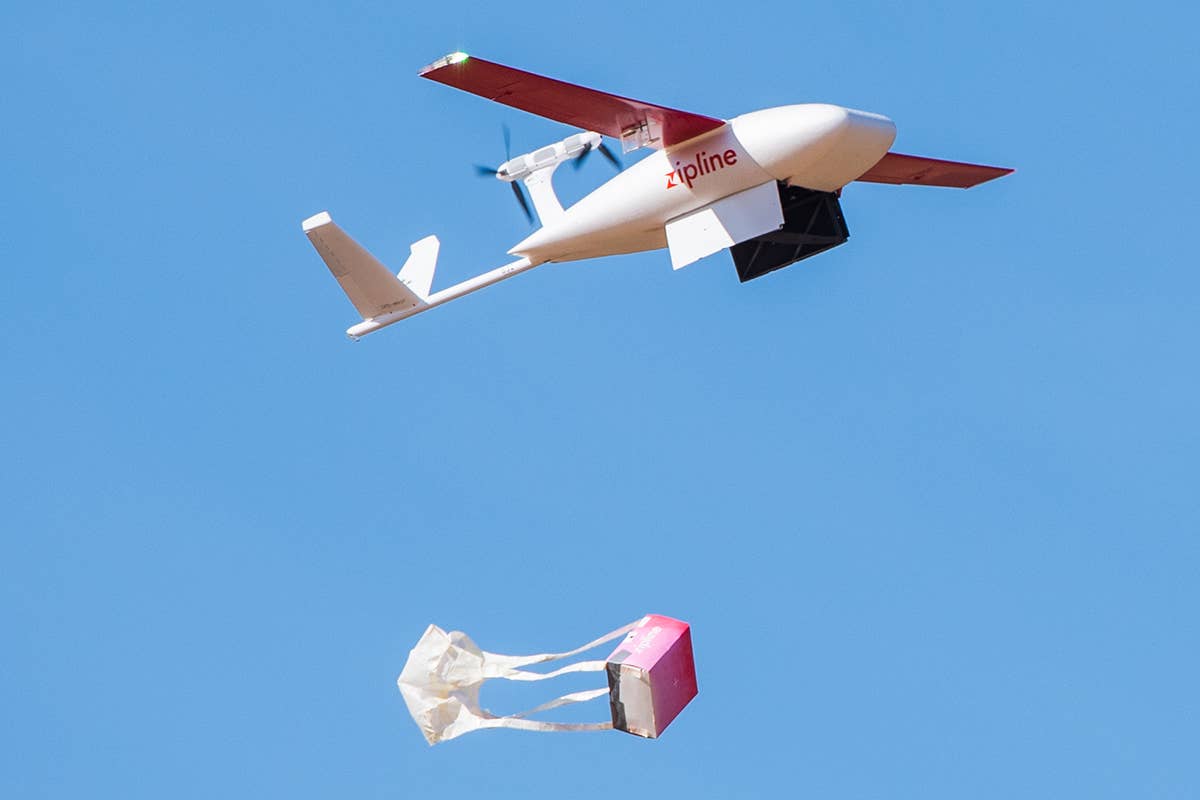Zipline Receives FAA Part 135 Carrier Certificate
California-based Zipline has become the fourth drone delivery company to receive an FAA Part 135 carrier certificate to fly in the U.S.

Zipline’s electric, autonomous, fixed-wing drones fly precise routes to customer locations, drop packages at low altitudes, and return to distribution centers. [Courtesy: Zipline]
California-based Zipline has become the fourth drone delivery operator to receive an FAA Part 135 carrier certificate to fly in the U.S.
In its announcement Tuesday, Zipline said the certificate puts it on track to launch the nation’s “longest range on-demand” commercial drone delivery service with “operations covering the largest area and greatest distance of any uncrewed commercial aircraft delivery system in the country.”
“Today, on average, Zipline makes a delivery every four minutes—ensuring people get access to the products they need, the moment they need them,” said Keller Rinaudo, Zipline co-founder and CEO. “With our Part 135 certification, and in close collaboration with our partners and the FAA, we are one step closer to making safe, clean and quiet instant delivery a reality for communities across the U.S.”
Already conducting limited operations with Walmart in Arkansas since November under FAA Part 107, initial flights of the unmanned aircraft systems (UAS) will operate out of Zipline’s hub in Kannapolis, North Carolina, under Part 135.
“Our Part 135 certification reflects Zipline's commitment to safety and innovation, and is a testament to the rigor and professionalism of every aspect of our operations,” said Zipline’s U.S. director of UAS flight operations Joseph Marshall in an email statement to FLYING. “This starts with a solid training foundation—our RPICs (remote pilots in command) go through a robust, FAA-approved training program to ensure the highest levels of knowledge and proficiency.
“We recognize that commercial drone delivery operations are fairly new, and we aim to be exceptional partners in the communities we serve—in the airspace and on the ground,” Marshall said. “Overall, our commitment to safe airspace integration is unparalleled.”
As a Part 135 drone operator, Zipline joins Amazon (NASDAQ: AMZN), UPS Flight Forward (NYSE: UPS). and Wing Aviation LLC, which is owned by the parent company of Google (NASDAQ: GOOGL).
About the Aircraft
Zipline calls its delivery aircraft Zips. These v-tailed, fixed-wing, electric battery-operated drones are designed to fly autonomously, beyond visual line of sight (BVLOS), at about 52 knots (60 mph) with a range of 86 nm (160 km). The six-foot-long aircraft have a wingspan measuring 10 feet, and a payload capacity of up to 4 pounds.
Zips fly at altitudes between 300 and 400 feet agl, and descend to around 60 to 80 feet agl before deploying their packages.
The company says Zips can determine their own location within a three-dimensional space down to a single centimeter. The aircraft are equipped with a low-altitude wind prediction system that gives Zips data for re-routing autonomously to avoid potentially troublesome weather.
Zips come with an acoustic detect and avoid (DAA) system that uses tiny microphones designed to give the drone a 360-degree awareness of air traffic with a range up to 1.25 miles (2 km).
After dropping their packages via parachute, Zips are designed to return to their distribution centers and land without runways using a recovery system inspired by the cables and tailhooks used on naval aircraft carriers.
When a Zip approaches the recovery system, a wire extends into a 1.5-centimeter tailhook on the end of every Zip. The recovery system then catches, slows, and stops Zipline’s drones.
Zipline says the Kannapolis facility is capable of serving customers within a nearly 8,000-square-mile area and delivering half a ton of supplies per day.
Later this month, Zipline plans to begin operations from Kannapolis with partners Novant Health, Magellan Rx Management, and Cardinal Health. The company acquired significant experience in medical-related drone deliveries when it began operating in Rwanda in 2016 and three years later in Ghana. Overall, Zipline has logged more than a million kilometers of autonomous flights.

Subscribe to Our Newsletter
Get the latest FLYING stories delivered directly to your inbox






